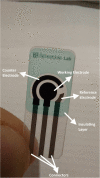Recent advances in electrochemical sensor technologies for THC detection-a narrative review
- PMID: 35292105
- PMCID: PMC8925211
- DOI: 10.1186/s42238-022-00122-3
Recent advances in electrochemical sensor technologies for THC detection-a narrative review
Erratum in
-
Correction: Recent advances in electrochemical sensor technologies for THC detection-a narrative review.J Cannabis Res. 2022 Jul 14;4(1):38. doi: 10.1186/s42238-022-00150-z. J Cannabis Res. 2022. PMID: 35836255 Free PMC article. No abstract available.
Abstract
Background: Δ9-tetrahydrocannabinol (THC) is the main psychoactive component and one of the most important medicinal compounds in cannabis. Whether in human body fluids and breath or in laboratory and field samples, rapid and easy detection of THC is crucial. It provides insights into the impact of THC on human organism and its medicinal benefits, it guides the cannabis growers to determine different stages of the growth of the plant in the field, and eventually it helps scientists in the laboratory to assure the quality of the products and determine their potency or better understand the product development procedures. The significance of fast THC detection in forensic analysis also cannot be overlooked. Electrochemical sensor technologies are currently in the focus of attention for fast, easy, and low-cost detection of THC.
Method: In this work, we review the recent advances in sensor technologies developed for the purpose of fast and accurate THC detection. The research works performed mostly in the past decade and those detecting THC directly without any derivatization were the main target of this review. The scope of this narrative review was the reports on detecting THC in synthetic samples and plants as well as oral fluid.
Results: Electrochemical sensor technologies are sensitive enough and have the potential for fast, easy, and low-cost detection of THC for roadside testing, THC trending in growing cannabis plants, THC product development and formulation for medical purposes, etc., and they can provide an alternative for costly chromatography and mass spectrometry-based methods.
Conclusion: The main challenges facing these sensors, however, are nonspecific interaction and the interference of compounds and species from the matrix. Special requirement for storing sensors modified with antibodies or proteins is another challenge in this field. Preparing long-lasting and reusable sensors is a field worthy of attention.
Keywords: Cannabis; Electrochemical detection; Sensor; THC; Δ9-tetrahydrocannabinol.
© 2022. The Author(s).
Conflict of interest statement
The authors declare that they have no competing interests
Figures





References
-
- Amini K, Kraatz HB. Recent developments in biosensor technologies for pathogen detection in water. JSM Environ Sci Ecol. 2015;3(1):9.
-
- Amini K, Kraatz H-B. Recent advances and developments in monitoring biological agents in water samples. Rev Environ Sci Bio/Technol. 2015;14(1):23–48. doi: 10.1007/s11157-014-9351-5. - DOI
-
- Amini K, Kraatz H-B. Toll-like receptors for pathogen detection in water: challenges and benefits. Int J Environ Anal Chem. 2016;96(9):836–844. doi: 10.1080/03067319.2016.1209661. - DOI
Publication types
LinkOut - more resources
Full Text Sources
Miscellaneous

